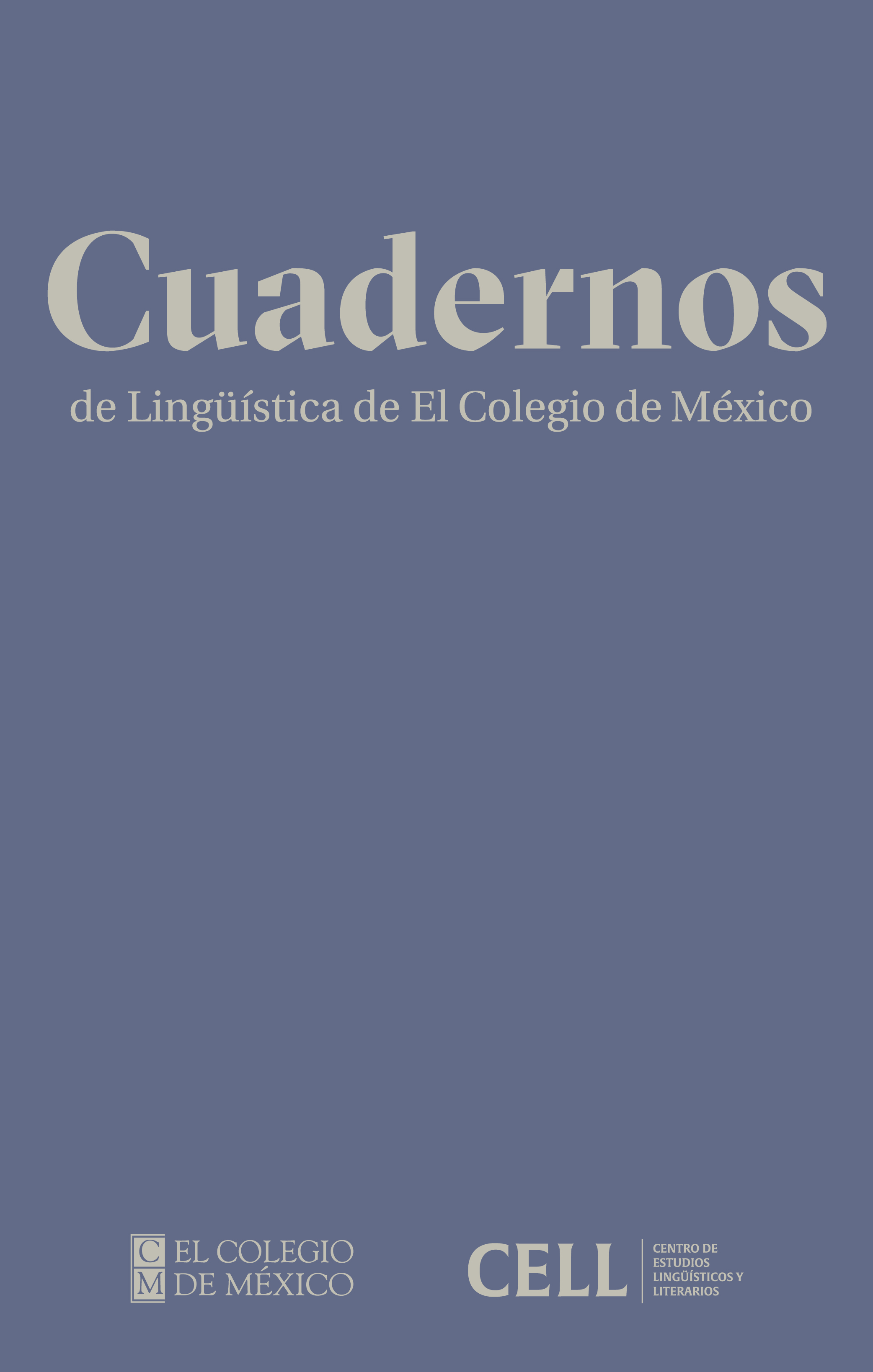Dossier Adposiciones Presentación: Una introducción tipológica
DOI:
https://doi.org/10.24201/clecm.v10i00.308Palabras clave:
postposiciones, adposicionesResumen
En los últimos 30 años, el tema de las adposiciones ha ido cobrando cada vez mayor interés en los estudios lingü.sticos (ver por ejemplo Zwicky 1992, Jolly 1993, Haspelmath 2003, Delancey 2005, Libert 2006 y 2013, Kurzon y Adler 2008, Hagège 2010, Dryer 2013; MacKenzie 2013, y Guerrero 2019). En general, se reconoce que, aunque las adposiciones son unidades relacionales no necesariamente presentes en todas las lenguas (no son universales),1 los sistemas de adposiciones son sin embargo muy comunes y de uso muy frecuente en las lenguas del mundo, pero suelen presentar un conjunto heterogéneo de propiedades de orden morfológico, sintáctico y semántico (son muy variables).
Descargas
Citas
Álvarez González, Albert. 2023. The origin of instrumental postpositions in Cahita (Uto- Aztecan): a new account. Cuadernos de Lingüística de El Colegio de México 10. e270. DOI: https://doi.org/10.24201/clecm.v10i00.270 DOI: https://doi.org/10.24201/clecm.v10i00.250
Bakker, D. 2013. Person marking on adpositions. En Dryer, M. & Haspelmath, M. (eds.), The World Atlas of Language Structures Online. Leipzig: Max Planck Institute for Evolutionary Anthropology.
Bickel, B. & Zúñiga, F. 2017. The ‘word’ in polysynthetic languages: phonological and syntactic challenges. En Fortescue, M., Mithun, M. & Evans, N. (eds.), The Oxford Handbook of Polysinthesis. Oxford: Oxford University Press. DOI: https://doi.org/10.1093/oxfordhb/9780199683208.013.52
Creissels, Denis. 2006. Syntaxe générale: una introduction typologique. París: Hermes.
Creissels, Denis. 2023. The grammaticalization path deictic spatial adverb > adposition. Cuadernos de Lingüística de El Colegio de México 10. e269. DOI: https://doi.org/10.24201/clecm.v10i0.269. DOI: https://doi.org/10.24201/clecm.v10i00.269
DeLancey, S. 1997. Grammaticalization and the gradience of categories. Relator nouns and postpositions in Tibetan and Burmese. En Bybee, J., Haiman, J. & Thompson, S. A. (eds.), Essays on language function and language type. 51-69. Ámsterdam/Philadelphia: John Benjamins. DOI: https://doi.org/10.1075/z.82.07del
DeLancey, S. 2005. Adpositions as a non-universal category. En Frajzyngier, Z., Hodges, A. & Rood, D. (eds.), Linguistic diversity and language theories. Ámsterdam: John Benjamins, 185-202. DOI: https://doi.org/10.1075/slcs.72.10del
Dixon, R. M. W. 2010. Basic linguistic theory. Vol. 1. Methodology. Oxford: Oxford University Press.
Dryer, M. S. 2013. Order of adposition and noun phrase. En M.S. Dryer & M. Haspelmath (eds.), The world atlas of language structures (Online). Leipzig: Max Planck Institute for Evolutionary Anthropology.
Fagard, B., Stosic, D. & Pinto de Lima, J. 2020. Complex adpositions in Romance: emergence and variation. En Fagard, B., Pinto de Lima, J., Stosic, D. & Smirnova, E., Complex adpositions in European languages: a micro-typological approach to complex nominal relators. 33-64. Berlín: De Gruyter Mouton. DOI: https://doi.org/10.1515/9783110686647-002
Givón, T. 1971. Historical syntax and synchronic morphology. CLS Proceedings 7. 394-415.
Guerrero, L. (ed.). 2019. Adposiciones y elementos de su tipo en lenguas de América. Ciudad de México: Universidad Nacional Autónoma de México.
Hagège, C. 2010. Adpositions. Oxford: Oxford University Press.
Haspelmath, M. 1998. Does grammaticalization need reanalysis? Studies in Language 22(2). 315-351. DOI: https://doi.org/10.1075/sl.22.2.03has
Haspelmath, M. 2003. Adpositions. En W. J. Frawley (ed.), International Encyclopedia of Linguistics, 39-41. Oxford/New York: Oxford University Press.
Haspelmath, M. 2011. The indeterminacy of word segmentation and the nature of morphology and syntax. Folia linguistica 45(1). 31-80. DOI: https://doi.org/10.1515/flin.2011.002
Haspelmath, M. 2019. Indexing and flagging, and head and dependent marking. TeReo1, no. in Honour of Frantisek Lichtenberk. 93-115.
Heine, B. & Kuteva, T. 2002. World lexicon of grammaticalization. Cambridge: Cambridge University Press. DOI: https://doi.org/10.1017/CBO9780511613463
Heine, B. 2002. On the role of context in grammaticalization. En Wischer I. & Diewald, G. (eds.). New reflections on grammaticalization. Ámsterdam: John Benjamins. DOI: https://doi.org/10.1075/tsl.49.08hei
Herce, B. 2023. Adpositions. En Herce, B. 2023. Adpositions. En Van Lier, E. (ed.), The Oxford handbook of word classes. Oxford: Oxford University Press. DOI: https://doi.org/10.1093/oxfordhb/9780198852889.013.12
Hernández Chincoya, F. & Mora-Bustos, A. 2023. El sistema de adposiciones del chichimeco. Cuadernos de Lingüística de El Colegio de México 10. e271. DOI:https://doi.org//10.24201/clecm.v10i00.271 DOI: https://doi.org/10.24201/clecm.v10i00.271
Jolly, J. 1993. Preposition assignment in English. En Van Valin, R. (ed.), Advances in role and reference grammar, 275-310. Ámsterdam/Philadelphia: John Benjamins. DOI: https://doi.org/10.1075/cilt.82.08jol
Kahr, J. C. 1975. Adpositions and locationals: typology and diachronic development. Working Papers on Language Universals 19. 21-54.
Kortmann, B. & König, E. 1992. Categorial reanalysis: the case of deverbal prepositions. Linguistics 30(4). 671-698. DOI: https://doi.org/10.1515/ling.1992.30.4.671
Kurzon, D. & Adler, S. 2008. Adpositions: pragmatic, semantic and syntactic perspectives. Ámsterdam/Philadelphia: John Benjamins. DOI: https://doi.org/10.1075/tsl.74
Lehmann, C. 1985. Grammaticalization: synchronic variation and diachronic change. Lingua e Stile 20. 303-318.
Lehmann, C. 2023. Postpositions in Cabecar. Cuadernos de Lingüística de El Colegio de México 10. e268. DOI: https://doi.org//10.24201/clecm.v10i00.268 DOI: https://doi.org/10.24201/clecm.v10i00.268
Libert, A. R. 2006. Ambipositions. (LINCOM Studies in Language Typology). Munich: Lincom Europa.
Libert, A. R. 2013. Adpositions and other parts of speech. Peter Lang: Frankfurt. DOI: https://doi.org/10.3726/978-3-653-03682-4
Matras, Y. 2007. The borrawability of structural categories. En Matras, Y. & Sakel, J. (eds.), Grammatical borrowing in cross-linguistic perspective, 31-73. Berlín: DeGruyter. DOI: https://doi.org/10.1515/9783110199192.31
MacKenzie, J. L. 2013. Spatial adpositions between lexicon and grammar. En MacKenzie, J. L. & Olbertz, H. (eds.), Casebook in functional discourse grammar. 67-93. Ámsterdam/Philadelphia: John Benjamins. DOI: https://doi.org/10.1075/slcs.137.04mac
Mora-Bustos, A.; Ortiz Villegas, A. I.; García Zúñiga, H. A. & Hernández Hernández, N. 2023. Clases de adposiciones en tres lenguas otomangues. Cuadernos de Lingüística de El Colegio de México 10.e272. DOI: https://doi.org//10.24201/clecm.v10i00.272 DOI: https://doi.org/10.24201/clecm.v10i00.272
Payne, T. E. 1991. Describing morphosyntax: a guide for field linguists. Cambridge: Cambridge University Press.
Schacter, P. & Shopen, T. 2007. Parts-of-speech systems. En Shopen, T. (ed.), Language typology and syntactic description, 1. (2da ed.), 1-60. Cambridge: Cambridge University Press. DOI: https://doi.org/10.1017/CBO9780511619427.001
Schiering, R.; Bickel, B. & Hildebrandt, K. A. 2010. The prosodic word is not universal, but emergent. Journal of Linguistics 46(3). 657-709. DOI: https://doi.org/10.1017/S0022226710000216
Zwicky, A. M. 1992. Jottings on adpositions, case inflections, government, and agreement. En Brentari, Diane; Larson, Gary N. & MacLeod, Lynn A. (eds.), The joy of grammar. A festschrift in honor of James D. McCawley. Ámsterdam/Philadelphia: John Benjamins. DOI: https://doi.org/10.1075/z.55.23zwi
Última actualización
Cómo citar
-
Resumen386
-
PDF210
-
XML10
-
EPUB21
-
Kindle62
-
MP31
Número
Sección
Licencia
Derechos de autor 2023 Albert Álvarez González, Zarina Estrada Fernández, Manuel Peregrina Llanes

Esta obra está bajo una licencia internacional Creative Commons Atribución-NoComercial-SinDerivadas 4.0.
Los autores conservan los derechos sobre su obra y tienen libertad de diseminar su trabajo y hacerlo disponible en otros lugares (repositorios, páginas web personales, antologías), pero garantizarán a esta revista el derecho de primera publicación y se comprometen a citar CLECM como referencia de la publicación original.
Los trabajos publicados en Cuadernos de Lingüística de El Colegio de México se publican bajo los términos que se indican en la Licencia Creative Commons con Atribución-NoComercial-SinDerivadas 4.0 Internacional.








